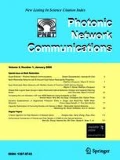Abstract
Optical data center networks (ODCNs) are constructed by connecting geographically distributed data centers with optical networks. Due to the superiorities in computing and transmission performances, ODCNs have been widely acknowledged as a promising network paradigm to support the popular enterprise IT applications such as cloud computing and 3D rendering. However, the ever-increasing traffic burst and the expensive hardware upgrading impose more severe challenges on the design of resource allocation scheme in ODCNs, which is urgently required to take into account not only the service quality but also the economical profit of service provider. In this paper, we focus on the service degradation in ODCNs which has been proven efficient in reducing the denied requests in the overloaded network scenario by releasing portion of the occupied network resources with the acceptable service quality loss. Unlike the service degradation scheme in previous works, we first consider the impact of the time characteristics of service requests on the resource utilization and propose a novel time-dependent load-balancing service degradation (TD-LBSD) framework. In the TD-LBSD framework, a time-dependent link weight scheme is invented for the allocation of bandwidth resource to avoid the potential traffic congestion that is usually induced by the ignored dynamic nature of service requests. In order to support the high-level prepaid requests with unknown holding time, we also propose a statistical method to estimate the residual time of the occupied lightpaths based on the probability distribution of the holding time of past requests. Simulation results verified that our proposed service degradation framework outperforms the previous schemes with the profit gain of 6.2% and the reduced traffic congestions of 16.39% at best.







Similar content being viewed by others
Notes
When a request arrives with its own original holding time, if this request does not leave, its residual time means the holding time minus the passed time. Thus, the residual time is always less than or equal to the holding time.
For all requests on the lightpath, the maximal residual time among them is defined as the residual time of the lightpath.
References
Gharbaoui, M., Martini, B., Castoldi, P.: Anycast-based optimizations for inter-data-center interconnections [Invited]. J. Opt. Commun. Network. 4(11), SI B168–B178 (2012)
Hou, W., Guo, L., Liu, Y., et al.: Resource management and control in converged optical data center networks: survey and enabling technologies. Comput. Netw. 88, 121–135 (2015)
Meng, X., Pappas, V., Zhang, L.: Improving the scalability of data center networks with traffic-aware virtual machine placement. In: Proceedings of INFOCOM (2010)
Sun, G., Anand, V., Liao, D., et al.: Power-efficient provisioning for online virtual network requests in cloud-based data centers. IEEE Syst. J. 9(2), 427–441 (2015)
Anastasopoulos, M.P., Tzanakaki, A., Rofoee, B.R., et al.: Optical wireless network convergence in support of energy-efficient mobile cloud services. Photon. Netw. Commun. 29(3), 269–281 (2015)
Li, M., Bi, J., Li, Z.: Improving consolidation of virtual machine based on virtual switching overhead estimation. J. Netw. Comput. Appl. 59, 158–167 (2016)
Ji, Y., Zhang, J., Zhao, Y., et al.: Prospects and research issues in multi-dimensional all optical networks. Sci. China Inf. Sci. 59, 101301 (2016). doi:10.1007/s11432-016-0324-7
Savas, S.S., Habib, M.F., Tornatore, M. et al.: Exploiting degraded-service tolerance to improve performance of telecom networks. In: Proceedings of OFC (2014)
Savas, S.S., Habib, M.F., Tornatore, M., et al.: Network adaptability to disaster disruptions by exploiting degraded-service tolerance. IEEE Commun. Mag. 52(12), 58–65 (2014)
Mukherjee, B., Savas, S.S., Bao, N.H.: Network adaptability to disasters by exploiting degraded-service tolerance. In : Proceedings of ICOCN (2014)
Liang, Q., Zhang, J., Zhang, Y., et al.: The placement method of resources and applications based on request prediction in cloud data center. Inf. Sci. 279, 735–745 (2014)
Kong, X., Lin, C., Jiang, Y., et al.: Efficient dynamic task scheduling in virtualized data centers with fuzzy prediction. J. Netw. Comput. Appl. 34(4), 1068–1077 (2011)
Xia, M., Tornatore, M., Sevilla, S., et al.: A novel SLA framework for time-differentiated resilience in optical Mesh networks. J. Opt. Commun. Netw. 3(4), 312–322 (2011)
Yang, H., Zhang, J., Zhao, Y., et al.: Experimental demonstration of time-aware software defined networking for OpenFlow-based intra-datacenter optical interconnection networks. Opt. Fiber Technol. 20(3), 169–176 (2014)
Din, D., Chou, C.: Virtual topology reconfiguration for mixed-line-rate optical WDM networks under dynamic traffic. Photon. Netw. Commun. 30(2), 290–308 (2015)
Xu, Z., Huang, J., Zhou, Z., et al.: A novel grooming algorithm with the adaptive weight and load balancing for dynamic holding-time-aware traffic in optical networks. Opt. Fiber Technol. 19(5), 392–399 (2013)
Tornatore, M., Baruffaldi, A., Zhu, H., et al.: Holding-time-aware dynamic traffic grooming. IEEE J. Sel. Areas Commun. 26(3), 28–35 (2008)
Zuo, L., Shu, L., Dong, S., et al.: Dynamically weighted load evaluation method based on self-adaptive threshold in cloud computing. Mobile Netw. 22(1), 4–18 (2017)
Ren, S., Schaar, M. V. D.: Joint design of dynamic scheduling and pricing in wireless cloud computing. In: Proceedings of INFOCOM (2013)
Ghamkhari, M., Mohsenian-Rad, H.: Data centers to offer ancillary services. In: Proceedings of SmartGridComm (2012)
Acknowledgements
This work was partly supported by National Natural Science Foundation of China (Nos. 61471109 and 61501104) and Fundamental Research Funds for the Central Universities (Nos. N150406001, N150401002 and N161608001).
Author information
Authors and Affiliations
Corresponding author
Rights and permissions
About this article
Cite this article
Zong, Y., Yu, C., Liu, Y. et al. Time-dependent load-balancing service degradation in optical data center networks. Photon Netw Commun 34, 411–421 (2017). https://doi.org/10.1007/s11107-017-0710-3
Received:
Accepted:
Published:
Issue Date:
DOI: https://doi.org/10.1007/s11107-017-0710-3




